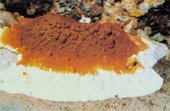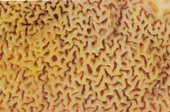True dry rot (Serpula lacrymans)
True dry rot occurs in buildings and belongs to the Coniophoraceae family.
It is one of the most dangerous indoor fungi, as its mycelia enable it to spread over a wide area and it can also grow through masonry. As it is capable of carrying moisture through its strands over long distances, it can also attack relatively dry wood.
True dry rot affects both coniferous and deciduous wood, and attacks not only structural timbers, like beams and rafters, but also floorboards, skirting boards, wall panelling, door frames and other wood-containing materials. Dry rot degrades the cellulose in the wood and so causes brown rot to occur.
Combating dry rot is a meticulous process, as residues of mycelia and the very resistant spores can start to grow again if conditions are favourable.
What does it look like?
Dry rot’s fruit bodies are fleshy and soft, but tough and hardy. They have a white, rubbery margin, are finely pleated in the middle and coloured reddish-brown by the fine spores that lie on the top of them. In extreme cases, this fruit body can reach a diameter of up to 2 metres. Initially, the fungus mycelia are soft and fluffy, but later collapse in on themselves and lie on the wood like a silvery layer of dust. The grey strands are particularly characteristic. When fresh, they can be up to 8mm thick and are often surrounded by lobate inter-mycelia. With these strands, the dry rot can spread throughout an entire building.
Where does dry rot occur?
Dry rot occurs mostly in the cellars, ground floors and attics of older buildings. High humidity and high wood moisture content favour its development and encourage infestation. As it reacts sensitively to moisture fluctuations, it prefers to grow hidden away in the spaces between floors and ceilings, or behind wall panels where the climate is more stable. That’s why it is often only discovered when wood surfaces begin to bulge or when the fruiting body actually becomes visible on the affected wooden objects.
How is the wood attacked?
Spores spread fungi, and spores grow in great numbers in the fruit bodies of older fungi. The growing fruit body of a dry rot fungus can cultivate up to 6,000 spores per square centimetre every minute. Such great numbers mean that spores can be found everywhere. If a spore falls on a suitable surface with sufficient moisture, it can germinate and a small fungal strand grows out of the spore, the hypha, which divides and branches out permanently, creating a fungal mycelium. The hyphae release enzymes which break down the wood into tiny sugar components which serve the fungus as nutrition.
After a certain development phase that differs according to fungus type and living conditions, the fungus forms a fruit body and spreads its offspring around din the form of spores.
What damage can true dry rot do?
Due to its concealed modus Vivendi, dry rot can cause considerable damage before it is actually discovered. Infestation can lead to the complete destruction of a structure. Fungal damage in buildings are often caused by dry rot (in a quarter of all cases, on average).
What can be done to combat dry rot?
Fungal determination and an appraisal of the infestation in hand must be carried out by an expert. The implementation of curative measures in Germany is based on the wood preservation standard DIN 68800 part 4 " Wood preservation; measures for the eradication of fungi and insects ". These measures may only be carried out by qualified companies and personnel.


